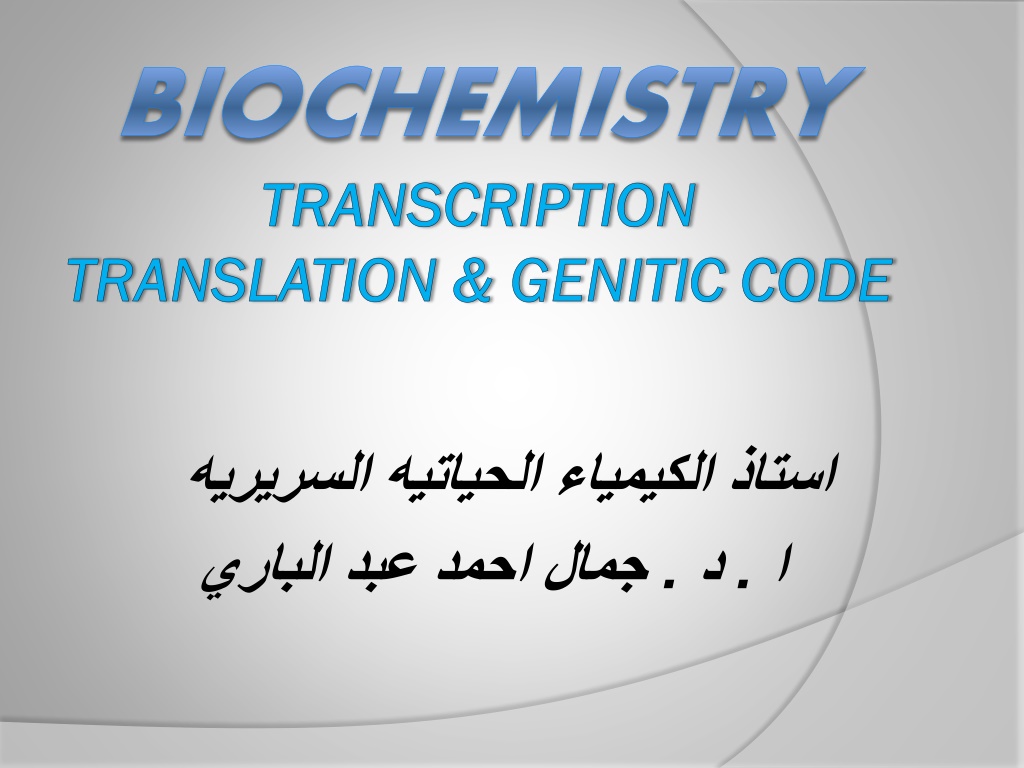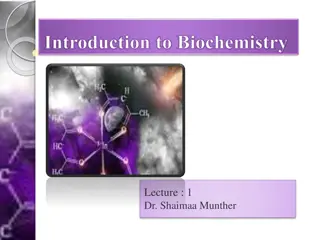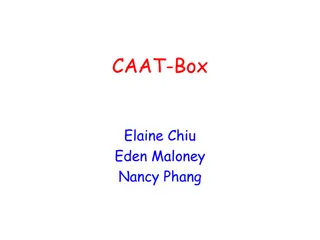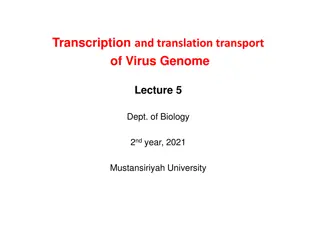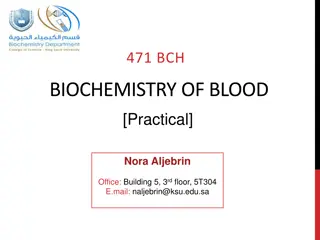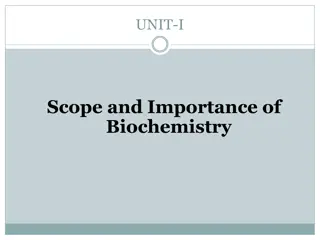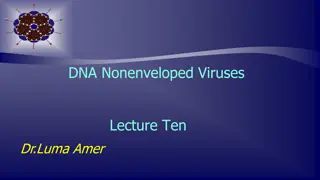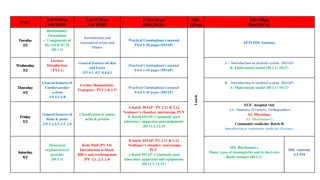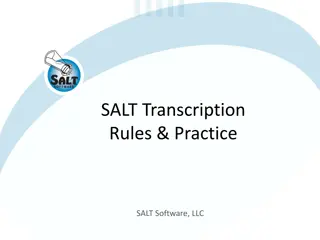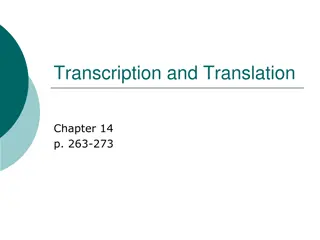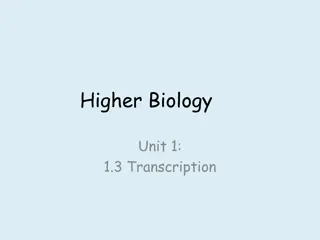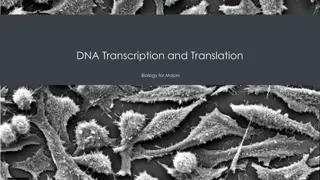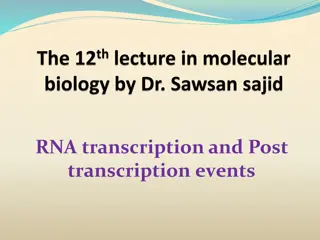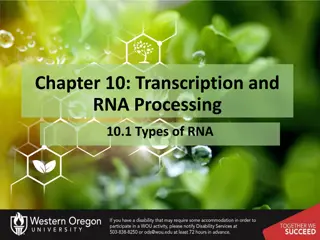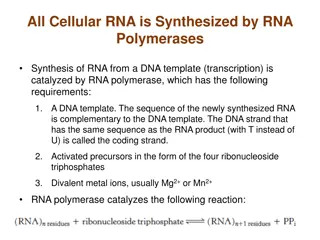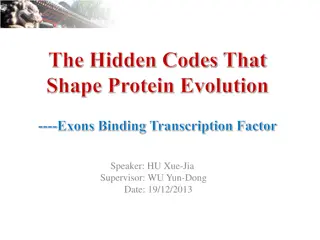Understanding Transcription in Biochemistry
Transcription is a crucial process where RNA is synthesized from DNA, involving complex steps of initiation, elongation, and termination. This process is regulated by specific DNA regions, proteins, and enzymes like DNA-dependent RNA polymerase. The differences between DNA and RNA synthesis lie in the lack of primer requirement, involvement of one complementary strand, single-stranded RNA, and the use of uracil instead of thymidine. Explore the detailed mechanisms and functions of various components involved in transcription.
Uploaded on Sep 20, 2024 | 0 Views
Download Presentation

Please find below an Image/Link to download the presentation.
The content on the website is provided AS IS for your information and personal use only. It may not be sold, licensed, or shared on other websites without obtaining consent from the author. Download presentation by click this link. If you encounter any issues during the download, it is possible that the publisher has removed the file from their server.
E N D
Presentation Transcript
BIOCHEMISTRY TRANSCRIPTION TRANSCRIPTION TRANSLATION & GENITIC CODE TRANSLATION & GENITIC CODE . .
Transcription Transcription: Is the specification of sequence of RNA by that of DNA. The synthesis of RNA from DNA is very complex involving one group of RNA polymerase enzymes and a number of associated proteins. The general steps are 1- Initiation. 2- Elongation. 3-Termination.
Initiation Initiation: : A number of DNA regions and proteins factor that bind to these sequence to regulate the initiation of transcription. The process is best understood in prokaryotes and viruses but in mammalian cells is very different that is the RNA are made as precursor molecules that have to be processed into mature, active RNA. The sequence of RNA molecule is complementary to the sequences of DNA in one strand of the double strand. The strand that is transcript into RNA called template strand and the other referred as the coding strand. The process required an enzyme DNA-dependent RNA polymerase and number of substrates (ATP, GTP, CTP and UTP).
The differences between DNA and RNA synthesis The differences between DNA and RNA synthesis 1.The formation of RNA does not require a primer. 2. One of the complementary strands involve in RNA synthesis. 3. RNA is a single strands, while DNA is a double helix. 4. RNA that is transcript from non functional DNA had no function. 5.We need uracil instead of thymidine.
DNA- dependent RNA polymerase: Is the enzyme responsible for polymerization of RNA. The enzyme attached at specific site the promoter site. This enzyme exists as a core molecule composed of 4 subunit, 2 of these are identical to each other ( - subunit) and 2 are similar in size to each other but not identical (B and B'). The (sigma) factor in the core of the enzyme; help to attach the enzyme more tightly to the DNA molecule at the promoter sites. The m.wt of the enzyme is 500.000- 600.000.
Subunit Function ----- : Essential for farming the first intranucleolted bond. ': Has high affinity for DNA, the major forces holding the RNA Polymerase to the template DNA. O': That help the core more tightly t0 the DNA at promoter sit, and serve In E. coli to initiate the transcription.
After the binding the enzyme to promoter site, a conformational changes to the enzyme, then the first nucleotide (almost always purine) associated with initiation site on the B-subunit. In the presence of 4 nucleotides the enzymes move to the second base in the base in the template, a phosphodiester bond forms. The formation of RNA at its 5' end then follows the release of the o' factor while the elongation of RNA from 5' to its 3' end continues. Pyrophosphate is released in the polymerization reaction. In eukaryotic, and prokaryotes a purine is usually the first polymerized into the RNA molecule.
In elongation In elongation: A complex containing the core RNA polymerase progresses on the DNA and DNA unwinding must occur in order to provide access of base pairing. DNA unwinding is constant through the transcription =17 base pair/ polymerase.
Termination: Termination: Is signaled by a sequence in the template strand on the DNA molecule. The signal is recognized by termination protein called rho ( ) factor. More then one RNA polymerase may transcript the same template strand. Rho protein is important in producing RNA with characteristic molecular weight. Only part of DNA is transcript, the chain length must be determined by: 1. Control system that recognizes the termination site. 2. The structure and the activity of the enzyme RNA polymerase.
Translation and genetic code Translation and genetic code The data encoded in DNA are utilized in directing protein structure by means of the DNA functioning as a template for transcription with specific base sequence. The m-RNA then moves out of nucleus and combine with the ribosome. The information that is stored as the sequence of bases in the m-RNA provides the data for the synthesis of protein with specific amino-acid sequence. This involves the transfer of information from a system with four components (two purine and two pyrimidine) to one of twenty different amino acids.
Translation Translation: Is the process by which the base sequence in m-RNA codes for the amino-acid sequence in protein. The signal that determine the position of each amino acid in a protein is a specific sequences of three nucleoside bases. Example: AGU codes for serine. GGU codes for glycine.
Calculation the number of base triplets or codes, that there are 64 possible combinations. Since only 20 amino acid are present, there for, there was what called Degeneracy: This means that each amino acid is coded by more than one code. Example: Both UUU and UUC code for phenylalanine. GGC, GGA and GGG code for glycine. Only 61 of 64 possible codes for amino acids, since, UAA, UAG and UGA function as a signal for termination. And the sequence AUG severs as the codon for initiation of protein synthesis with methionine (which is also code for methionine residue in a peptide).
The genetic code for protein synthesis is universal, that is the same in all organisms. IN DEGENERACY : Several codes for the same amino acids usually differ only with respect to the third base.
Thank You 15 9/20/2024
